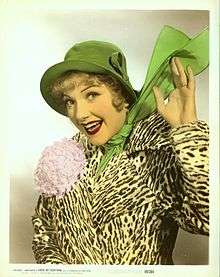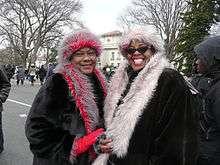Fake fur
Fake fur, also called faux fur, is known as pile fabric, which is engineered to have the appearance and warmth of animal fur.



It was first introduced on the market in 1929. These early attempts at imitation fur were made using hair from the alpaca, a South American mammal. In the 1940s, the quality of fake furs was vastly improved by advances in textile manufacture technology. However, the true modern fake furs were not developed until the mid-1950s, with the introduction of acrylic polymers as replacements for alpaca hair.[1]
However, its increasing popularity has been credited to its promotion by animal rights and animal welfare organizations which claim that it is an animal-friendly alternative to traditional fur clothing.[2]
Uses
Fake fur is used for all purposes where otherwise real fur (of animal origin) would be used, but also for stuffed animals, fashion accessory and home decorations like pillows, bedding and throws. It is also sometimes used for craft projects because it can be sewn on a sewing machine. Real fur is generally thicker and requires a special machine, hand sewing or an awl to sew it.[3] Lately, fake fur has been increasingly used in the mainstream teen fashion, for example the stores Abercrombie & Fitch[4] and American Eagle[5] use it for trapper hats and jackets. In the Soviet, and now Russian Army, fish fur is used as a slang term for the fake fur used on winter clothing and the ubiquitous ushanka hats. Similarly, fashion design labels such as Ralph Lauren and Chanel have promoted the use of fake fur in their collections.[6]
Comparison to real fur
Unlike real fur, fake fur is a fabric and is therefore relatively easy to sew. It does not require cold storage to prevent deterioration and is not prone to being eaten by moths.[7] A 1979 study commissioned by the Fund for Animals argued that the energy consumption for the production of one coat made out of fake fur was 35 kilowatt-hours (120,000 British thermal units), compared to 127 kWh (433,000 Btu) for trapped animals and 2,340 kWh (7,970,000 Btu) for animals raised in fur farms.[8] This study has been criticized as being biased and outdated.[9] It is also cheaper than real fur.
It is not as insulating and does not allow the skin to breathe as much as real fur.[10] It is also less biodegradable; it is made from various materials including blends of acrylic and modacrylic polymers derived from coal, air, water, petroleum and limestone. These synthetic materials can take a long time to break down, possibly anywhere from 500 to 1,000 years.[9] Fake furs are not able to keep snow from melting and re-freezing on the fiber filaments; this is very important, especially in hiking, mountain climbing, skiing and other outdoor activities which are done in extreme conditions.[2]
Use of actual fur
In a test by the Humane Society of the United States, coats labeled as having faux-fur trim used actual fur.[11] In the United States, up until 2012, a labeling loophole allowed any piece of clothing that contains less than US$150 of fur to be labeled without mentioning that it included fur.[11] This is the equivalent of thirty rabbits, three raccoons, three red foxes, three domestic dogs, or one bear.[11]
Fashion designers utilizing
Faux fur has increasingly become more popular for fashion designers to incorporate throughout their collections. Today's technology gives faux fur the qualities and techniques as real fur. Hannah Weiland, founder of Shrimps, a London-based faux fur company, says, “I love working with faux fur because it doesn't molt and it feels just as soft. If the faux kind feels as good, why use the real kind?”[12] Weiland is not the only designer taking advantage of faux fur qualities. Additionally, Stella McCartney incorporates faux fur throughout her collections with tagged patches reading “Fur Free Fur.”[13] In 2014, Hugo Boss pledged to become fur-free publicly in their 2014 Sustainability Report, relaying the message that animal cruelty is never fashionable. They look forward to moving on through the use of faux fur in their future collections. However, the notion of sustainability and ethics aren't always the reasoning behind designers decision for faux instead of real fur.[14] The ability to control more aspects of manufacturing such as color and volume is one reason designers choose faux. De Libran, the artistic director for Sonia Rykiel, incorporates both real and faux fur in her collections. Her incorporation of faux is based on the playfulness it portrays in her garments through the color and volume she is able to create.[13] In other brands, Prada embraced synthetics in their Fall/Winter 2007 collection. Miuccia Prada, the brand's owner and designer, commented she was bored with real fur, and as a result, she included all faux in her collection that year. However, today, Prada has been using both real and faux fur throughout their garments. In addition, Dries Van Noten, Hussein Chalayan, Julien David, Julie de Libran for Sonia Rykiel, Kate Spade, and many others all featured faux fur in their fall collections.[13]
Due to the controversy of fur garments, technology facilitating the production of fake furs has improved greatly since the early twentieth century. There are new tailoring and dyeing techniques to “disguise” fur and change the traditional image of fur with its conventional image associated with the elite fur-clad woman.[15] Modacrylic is a high-quality ‘fur’ alternative that gains attraction to its convincing look as an alternative to real fur. Howard Strachman of Strachman Associates, a New York-based agent for faux fur states that synthetic acrylic knitted fabrics have become a go-to resource for high-end faux fur, much of it coming from Asia. Prada put mohair faux fur in its Fall 2007 collection, whilst Max Mara and Dries Van Noten have also used this alternative.[16]
More authentic-looking methods of production are being researched. One technique is combining coarse and fine fibers to simulate mink or beaver fur.[17]
References
| Wikimedia Commons has media related to Faked furs. |
- "How fake fur is made". www.madehow.com. Retrieved 2018-10-30.
- "Definition from the Textile and Apparel Industries". Retrieved 2010-01-25.
- "how to sew torn mink coat?". Archived from the original on 2011-07-07. Retrieved 2009-08-19.
- "Abercrombie & Fitch | Fur Fleece Sweater - Betsy". Archived from the original on 2010-10-26. Retrieved 2009-08-19.
- "Women's AE Downtown Bomber - American Eagle Outfitters". Archived from the original on 2011-07-26. Retrieved 2009-08-19.
- "Search for faux fur on Ralph Lauren site". Archived from the original on 2012-09-10. Retrieved 2009-08-19.
- "Fur Care: Storage is a must". Archived from the original on 2009-07-01. Retrieved 2009-08-19.
- "Questions and Answers about Fur" (PDF). The Humane Society of the United States. 1998: 2. Archived from the original (PDF) on 2003-03-30. Retrieved 2008-08-17. Cite journal requires
|journal=(help) - "Should I choose fake fur over real fur". Retrieved 2010-03-17.
- Bekleidungsphysiologisches Institut Hohenstein. "Scientists prove nothing beats natural fur". Archived from the original on 8 August 2016. Retrieved 7 June 2016.
- Dawn, Karen (2008). Thanking the Monkey: Rethinking the Way We Treat Animals (1st ed.). New York City: HarperCollins. p. 110. ISBN 978-0-06-135185-3. Retrieved 12 March 2013.
- "Faux Real: In the Studio with Hannah Weiland of Shrimps - OPENING CEREMONY". www.openingceremony.us. Retrieved 2015-11-08.
- Iredale, Jessica (May 20, 2015). "Faux Fur: Better Than the Real Thing?". WWD.
- "Hugo Boss Is The Latest Luxury Brand To Go Fur-Free - Candid Magazine". www.candidmagazine.com. Retrieved 2015-11-09.
- Emberley, Julia (1997). The Cultural Politics of Fur. New York: Cornell University Press.
- Szmydke, Nina Jones, Paulina (2015-05-20). "Faux Fur: Better Than the Real Thing?". WWD. Retrieved 2017-11-06.
- "How fake fur is made - material, manufacture, making, history, used, processing, structure, steps, product". www.madehow.com. Retrieved 2017-11-06.